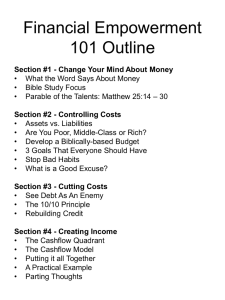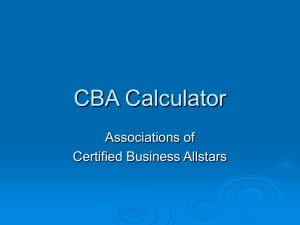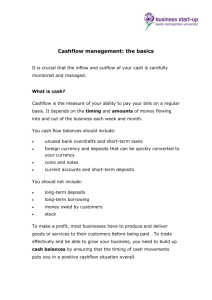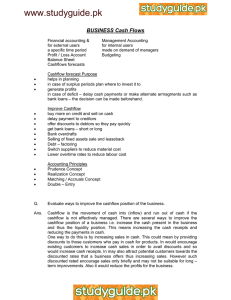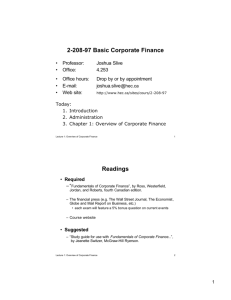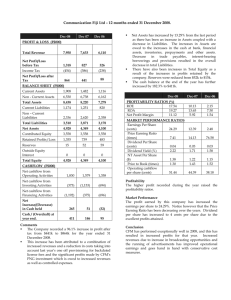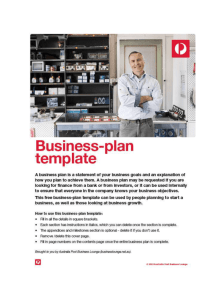www.studyguide.pk CASHFLOW MANAGEMENT
advertisement
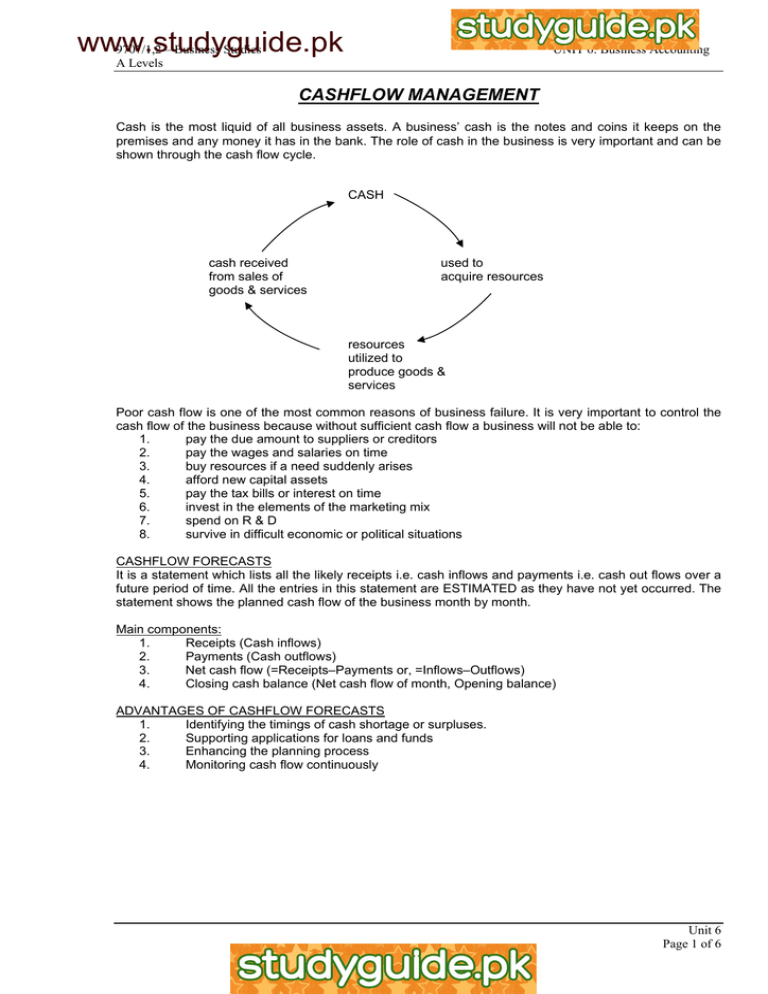
www.studyguide.pk 9707/1,2 – Business Studies UNIT 6: Business Accounting A Levels CASHFLOW MANAGEMENT Cash is the most liquid of all business assets. A business’ cash is the notes and coins it keeps on the premises and any money it has in the bank. The role of cash in the business is very important and can be shown through the cash flow cycle. CASH cash received from sales of goods & services used to acquire resources resources utilized to produce goods & services Poor cash flow is one of the most common reasons of business failure. It is very important to control the cash flow of the business because without sufficient cash flow a business will not be able to: 1. pay the due amount to suppliers or creditors 2. pay the wages and salaries on time 3. buy resources if a need suddenly arises 4. afford new capital assets 5. pay the tax bills or interest on time 6. invest in the elements of the marketing mix 7. spend on R & D 8. survive in difficult economic or political situations CASHFLOW FORECASTS It is a statement which lists all the likely receipts i.e. cash inflows and payments i.e. cash out flows over a future period of time. All the entries in this statement are ESTIMATED as they have not yet occurred. The statement shows the planned cash flow of the business month by month. Main components: 1. Receipts (Cash inflows) 2. Payments (Cash outflows) 3. Net cash flow (=Receipts–Payments or, =Inflows–Outflows) 4. Closing cash balance (Net cash flow of month, Opening balance) ADVANTAGES OF CASHFLOW FORECASTS 1. Identifying the timings of cash shortage or surpluses. 2. Supporting applications for loans and funds 3. Enhancing the planning process 4. Monitoring cash flow continuously Unit 6 Page 1 of 6 www.studyguide.pk 9707/1,2 – Business Studies UNIT 6: Business Accounting A Levels Q.1. A profitable business may run out of cash which a business recording a loss may have a cash surplus for that period. How is this possible? Explain. Ans. The answer to such situations ties in the fact that cash flow of a business is not the same as profit. The profit or loss of a business takes into account all expenses incurred or incomes received during a financial year only, whether they are on credit or even if they are totally unrelated to cash. Cash on the other hand is the inflow and outflow of money from banks or that within the premises of the business, regardless of it being received for past years’ sales or being paid for the next year’s expenses. Therefore, this leaves a gap between the cash of the business and its profit or loss. Some of the reasons will be illustrated blow. Firstly, the business may give credit period to its customers. This means that not all sales are on cash. E.g. a business selling goods worth $500,000 and incurring costs of $250,000, would make a profit of $250,000. However, if it only receives cash for $200,000 worth of goods, then this means that it has run out of cash. Then during the year a business may receive cash for sales of previous years. This would increase the cash of the business but have no affect on the profitability of the business. If in the current year the sales of business are less than its costs, then a loss is made while because of cash inflow of from debtors, the business is in possession on excess amounts of cash. Also if the owners of the business introduce more cash into their loss-making business, then this would increase the capital of the business but would have no effect on the profit or loss of the business. Again the liquidity of the business could be good while profitability is poor. Then the purchase and sale of fixed asset also has no effect whatsoever on the profit or loss of a business. A loss making business may sell its fixed asset which could considerably increase its cash balance depending on value of asset. On the other hand, a very profitable business may invest too much of its cash into the purchase of a fixed asset, causing it to run out of cash i.e. becoming illiquid. The sale of fixed asset an only have a very limited affect on profit or loss which is if its sale incurs a loss or profit depending on how much above or below net book value it was sold. Depreciation is another aspect which affects the profit of a business as it is an expense depicting fall in value of asset. If a very large amount of depreciation is incurred then this could cause the profit to drop considerably. However, the ash balance won’t be affected and so a large surplus of cash remains. A business can also pay its expenses like rent or advertising or interest in advance. These are prepayments for the upcoming year. They would lower the amount of cash available to business but such prepayments are not included in profit and loss account as these expenses haven’t been faced by the business. The business may also make credit purchases i.e. not pay the cash right away but after some time. These purchases would be recorded as costs in the profit and loss account and would lower the profit figure. However, as business hasn’t paid yet so the cash would remain within the business. The same is true for accruals. They are expenses incurred during a financial year but not yet paid for like the wages and salaries of workers. These would be included in profit and loss account and if a large amount of such expansion are incurred then the business may make loss. However, it could have a strong liquidity position as it still has a lot of cash left which wasn’t paid yet for expenses. Unit 6 Page 2 of 6 www.studyguide.pk 9707/1,2 – Business Studies UNIT 6: Business Accounting A Levels CASHFLOW MANAGEMENT ACTIVITY PAGE 460 1. Net cahsflow =x = 16 – 14 = 12 Cash at end =y = 2 + (-15) = -13 = (13) 2. One way to improve the forecasted cash flow would be to take a short-term loan or arrange for an overdraft. It is a flexible way of overcoming cash shortage quickly. It also helps to avoid any damage to relations with customers or suppliers that are possible through other methods. However, interest charges have to be paid. The other way could be by delaying payments to suppliers. No interest is charged on it and it won’t reduce consumer demand. However, relations with suppliers could deteriorate or supplier may even refuse to supply any further. 3. DEC ($000) CASH IN Capital injection Sales Revenue Total Cash In 16 + 10% of 16 17.6 17.6 CASH OUT Capital Expenditure Labour Materials Total Cash Out 4(2) 6 + 25% of 6 4 + 25% of 4 8 7.5 5 20.5 17.6 – 20.5 (2.9) (13) NET CASH FLOW Cash at Start CASHFLOW MANAGEMENT A business will have more effective control over its cash flow if it keeps up to-date business records, always plans ahead and operates an efficient credit control system which prevents slow or late payments. Managing the cash inflows and outflows is one of the most important tasks of the management. For this purpose the manager needs to assess the following factors. 1. The size and likely timings of the cash inflows and outflows 2. The availability of the sources of finance to cover periods when cash shortages occur 3. The opportunities to invest excess cash in the periods of cash surpluses WAYS TO IMPROVE THE CASHFLOW POSITION The following are ways to deal with cash flow problems: 1. stimulate or insist on cash sales offering discount schemes, if required 2. sell off extra stock of raw materials 3. sell off any fixed assets which might not be vital for operations 4. sell off fixed assets and lease them back 5. insist your debtors to pay on time, reduce your debtor period and offer a particular discount on early payments 6. sell debts to a debt factoring company 7. reduce or delay cash expenditures Unit 6 Page 3 of 6 www.studyguide.pk 9707/1,2 – Business Studies UNIT 6: Business Accounting A Levels 8. 9. 10. 11. 12. 13. only make essential purchases extend credit with selected suppliers reduce personal cash drawings from the business if possible inject new cash capital negotiate short-term loans or bank overdrafts obtain cheaper supplies of materials and components CASHFLOW MANAGEMENT Page 461 – ACTIVITY Ans.1. Interest rates increase means that the company would face an increase in its expenses as interest has to be paid in higher amount. One way that this would have an impact on the cashflow statement would be by higher cash payments each month as more interest has to be paid. So this would cause the deficit of net cashflow to worsen furthers since more cash is going out of business to pay the increased interest. This would also cause a further deficit in the closing cash balances each moth. This all goes onto endanger the liquidity of the business. Ans.2. Rise in inflation would likely result in the worsening of the cashflow of the business because inflation is a persistent rise in the prices of goods. So this would mean that the expenses of the business i.e. cash outflow would increase because the cost of materials, rents and rates, all would increase. And usually the business is unable to raise its selling price by the same as costs have risen and this also contributes towards increasing deficit of Asif Iqbal. Ans.3. Cashflow statements are forecasts or predictions into the future of the cash inflows and outflows of the business. This preparatory statement is very beneficial especially for starting new business like Asif Iqbal. From this statement, Asif is now able to monitor his cashflow on a month-to-month basis i.e. continuously. He now knows the periods of deficit and could submit this to the bank to be able to either arrange for aloan or an overdraft and negotiate its facilities. This would be necessary for laying to improve his cash flow position and overcome the deficit. Also the preparation of this statement shows the bank manager that Asif is further aware of the importance or careful management of the cash of the business. Therefore, the bank may be more willing to allow overdraft or loan as deemed appropriate. Then its is necessary to forewarn the bank for an impending overdraft. Otherwise the bank may refuse it. The forecast also sows the period when the business would slowly overcome its crisis. E.g. in Asif’s statement, the deficit decreases in July then as it was in June and continues to improve. However, there are disadvantages as well. The cashflow forecast is a prediction and wouldn’t be accurate. It could be a misleading document in the business plan as there is no surety of the sales being oven approximately as shown level. Also the rise in costs such as interest rates was unanticipated and not accounted for and so has made the forecast unreliable. Ans.4. There are several ways by which Asif would improve his cashflow. Firstly be could arrange for short-term loan or on overdraft with his bank for the extra cash. But this means paying very high interest rates. Then he may try to find cheaper suppliers for his business to reduce cashflow as les payments have to be made. But it is not easy to find a cheaper supplier providing material of the same quality. Finally Asif could try to negotiate with his suppliers to give him a credit period so that he could delay payments for his suppliers. This could, however strain relationships with Q.2. Evaluate any three ways to improve the cashflow low position of the business. Ans. There are several ways to improve the cashflow problems of a business i.e. increase the cash present in the business and thus the liquidity position. This means increasing the cash receipts and reducing the cash payments. One way to do this is try increasing sales in cash. This could mean by providing discounts to those customers that pay in cash for products. It would encourage customers (existing) to increase cash sales in order to avail discounts and so would increase cash receipts. It may also attract potential customers towards the discounted rates that a business has increasing sales. Unit 6 Page 4 of 6 www.studyguide.pk 9707/1,2 – Business Studies UNIT 6: Business Accounting A Levels However, such discounted rates encourage sales only briefly and may not be suitable for longterm improvements. Also it would reduce the profits for the business. Another way is by reducing debtor periods i.e. the credit time allowed to customers to pay for the sales. This would result in quicker receipts of sales and this reduces the cash tied up in debts. It may also mean a decrease in bad debts which is when a customer becomes totally unable to payback the debt because may be it has gone bankrupt. So the chances of receiving, more cash for sales increases. However, the drawback is the loss of customers, customers may go to those firms that offer a greater credit period. Finally, the firm may use factoring of debts to release cash from debts. This is when debts are sold off to a firm which also takes up the risk of bad debts. So the firm gets cash which it needs. Now the factoring company also takes up responsibility of collection of debts. However, the drawback is that large discounts have to be paid to debt factor. Q.3. Evaluate cashflow forecasts as an important planning tool for the business. Ans. The cashflow forecasts or cashflow budgets are an internal document drawn up for decision making and planning purposes. They help to control and monitor the cash inflows and outflows of the business. This preparation of cash budgets has several benefits. Firstly it allows the owners and managers to know the timings of shortages and surpluses beforehand. This can be seen clearly from the closing balances at the end of the statement. So it helps the managers to know in advance when to borrow cash or loans so that the arrangements can be made. If the business knows from before the likely period it is to run out of cash, then it can negotiate the interest rates with banks. Otherwise banks would charge a very high rate. Also if shortages are already known, then certain non urgent payments can be delayed to avoid such a situation. Then if a very large surplus is expected, then detailed plans can be made as to where to invest the cash. This could include buying a new machinery’s instead of telling the cash lie idle. The cashflow forecast also acts as a supporting application for funding. If the business asks for a loan, then the banks or any other tender would ask for a document showing the insolvency situation of a business and its performance. This is to allow tenders to have an idea of how important the loan is to the business as well as when they could expect the company to repay them. It would also allow them to see if the business would be able to pay them the interest and whether or to the company is likely to improve its performance in the future. It is also a common practice to produce a cashflow forecast statement in the planning stages of setting up a business. This is because banks usually want to see if the business knows how to manage its cashflow. The cashflow forecast also enhances the planning process. Careful planning in business has become more important in recent years. This helps to clarify aims and improve performance. Producing a cashflow forecast is a key part of the planning process because it is a document concerned with the future. The cashflow budget definitely allows the monitoring of the cashflow. Comparisons at the end of the financial year can be made with the cashflow forecast. This could be done to see how closely the actual figures like the predicted ones were. This would show where differences have occurred and may pinpoint any problems in the cashflow. It would show e.g. if an overpayment was made. So constant monitoring would ensure efficient planning of the cashflow. However, the preparation of cashflow forecasts is very difficult as they won’t be helpful if they aren’t accurate. In fact inaccuracy may actually cause the business to get into difficulties. Firstly, the forecast is based upon anticipated flows of cash into and out of the business. Some of these flows could be known like rent, rates and insurance. However, others usually variable costs such as raw materials may be more difficult to forecast as they could fluctuate unexpectedly with outputs or a change in price of suppliers. However, cash outflows are comparatively easier to predict than inflows. This is because sales are hardly even known except advanced orders. In such a case it is better to underestimate revenue and overestimate the costs. It is particularly difficult for new business. Then cashflow forecasts may be biased as well. Businesses may manipulate these to show the strength and performance of the business to be better than it actually is. This could be to gain benefits when borrowing money of lower interest rates. managers may also purposefully greatly overestimate costs and underestimate each to again could it whether the real / are better. Then several external factors may cause the cashflow forecast to be inaccurate. E.g. change sin interest rates or behaviour of competitors (reduction in selling prices). One way to deal with such a situation is to build contingency funds. This could be by making an allowance for each month as Unit 6 Page 5 of 6 www.studyguide.pk 9707/1,2 – Business Studies UNIT 6: Business Accounting A Levels unexpected costs that could be the cash outflow. Also adjustments could be made to the forecast so predictions are more accurate. Despite the fact that inaccuracy of predictions is a major drawback to the usefulness of cashflow forecasts, they are becoming increasingly necessary. It is because they have and will continue to prove a great help in managing the firm’s most liquid asset efficiently and effectively. Unit 6 Page 6 of 6
